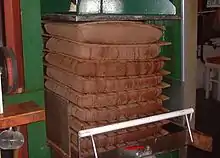Apple cider
Apple cider (also called sweet cider or soft cider or simply cider) is the name used in the United States and Canada for an unfiltered, unsweetened, non-alcoholic beverage made from apples. Though typically referred to simply as "cider" in the United States, it is not to be confused with the alcoholic beverage known as cider in other places, which is called "hard cider" in the US.

It is the liquid extracted from an apple and all its components, that is then boiled to concentration. The liquid can be extracted from the apple itself, the apple core, the trimmings from apples, or apple culls. It is typically opaque due to fine apple particles in suspension and generally tangier than commercial filtered apple juice, but this depends on the variety of apples used. Cider is typically pasteurized to kill bacteria and extend its shelf life, but untreated cider is common. In either form, apple cider is seasonally produced in autumn.[1] It is traditionally served on the Halloween, Thanksgiving, Christmas, and various New Year's Eve holidays, sometimes heated and mulled.
Nomenclature


Although the term cider is used for the fermented alcoholic drink in most of the world, it refers to fresh "apple cider" in the United States; hard cider is used there instead for the alcoholic drink.[2][3] In Canada, the fresh variety is usually referred to as "apple cider" with "cider" generally referring to the alcoholic variety.
While some states specify a difference between apple juice and cider, the distinction is not well established across the U.S. Massachusetts makes an attempt to at least differentiate fresh cider and processed apple juice: according to its Department of Agricultural Resources, "apple juice and apple cider are both fruit beverages made from apples, but there is a difference between the two. Fresh cider is raw apple juice that has not undergone a filtration process to remove coarse particles of pulp or sediment. Apple juice is juice that has been filtered to remove solids and pasteurized so that it will stay fresh longer. Vacuum sealing and additional filtering extend the shelf life of the juice."[4] This still leaves unfiltered apple juice that is no longer raw in a gray area, presumably cider but not labeled as such. The addition of sweeteners or reconstitution from concentrate are left even grayer.
Canada recognizes unfiltered, unsweetened apple juice as cider, fresh or not.[5]
Natural cider

Historically all cider was left in its natural state, unprocessed. In time, airborne yeasts present on apple skins or cider making machinery would start fermentation in the finished cider. Left on its own, alcohol would develop and forestall growth of harmful bacteria. When modern refrigeration emerged, cider and other fruit juices could be kept cold for long periods of time, retarding fermentation. Any interruption of the refrigeration, however, could allow bacterial contamination to grow. Outbreaks of illness resulted in government regulation requiring virtually all commercially produced cider to be treated either with heat or radiation.
As a result, natural raw cider is a specialty seasonal beverage, produced on-site at orchards and small rural mills in apple growing areas and sold there, at farmers markets, and some juice bars. Such traditional cider is typically made from a mixture of several different apples to give a balanced taste. Frequently blends of heirloom varieties such as Winesap, once among the most sought-after cider apples for its tangy flavor, are used. The US government requires that unpasteurized cider and juice have a warning label on the bottle.[6]
Even with refrigeration, raw cider will begin to become slightly carbonated within a week or so and eventually become hard cider as the fermentation process continues. Some producers use this fermentation to make hard cider; others carry it to acetification to create artisanal apple cider vinegar.
Treated cider
Many commercially produced ciders are pasteurized which extends their shelf life; the most common method used is pasteurization,[7] but UV irradiation[6] is also employed.
Pasteurization, which partially cooks the juice, results in some change of the sweetness, body and flavor of the cider;[6] irradiation has less noticeable effects.
Impetus for Federal level regulation began with outbreaks of E. coli O157:H7 from unpasteurized apple cider and other illnesses caused by contaminated fruit juices in the late 1990s.[8] The U.S. Food and Drug Administration (FDA) made proposals in 1998;[9] Canada began to explore regulation in 2000.[10]
The U.S. regulations were finalized in 2001, with the FDA issuing a rule requiring that virtually all juice producers follow Hazard Analysis and Critical Control Points (HACCP) controls,[11] using either heat pasteurization, ultraviolet germicidal irradiation (UVGI), or other proven methods to achieve a 5-log reduction in pathogens.[12]
Canada, however, relies on a voluntary Code of Practice for manufacturers, voluntary labelling of juice/cider as "Unpasteurized", and an education campaign to inform consumers about the possible health risks associated with the consumption of unpasteurized juice products.[5]
Commercial production

Modern cider making has come a long way from early forms of production that involved a man- or horse-powered crusher. These consisted of a stone or wood trough with a heavy circulating wheel to crush the fruit, and a large manual screw press to express the juice from the pulp. Straw was commonly used to contain the pulp during pressing, later replaced by coarse cloth. The Palmer Bros. Company, of Cos Cob, CT, made the most popular "modern" rack and cloth press from the mid 1800s to the mid 1900s, when production shifted to OESCO in Massachusetts. As technology advanced, rotary drum "scratters" came into use. Today, nearly all small pressing operations use electric-hydraulic equipment with press cloths and plastic racks in what is commonly called a "rack and cloth press", and electric hammermill "breakers".
Depending on the varieties of apples and using the optimal extraction methods, it takes about one third of a bushel (10 liters) to make a gallon (3.78 liters) of cider.[4] Apples are washed, cut, and ground into a mash that has the consistency of coarse applesauce. Layers of this mash are then either wrapped in cloth and placed upon wooden or plastic racks where a hydraulic press then squeezes the layers together, or the mash is distributed onto a continuous belt filter press,[13] which squeezes the pulp between two permeable belts fed between a succession of rollers that press the juice out of the pulp in a continuous, highly efficient operation. The resulting juice is then stored in refrigerated tanks, pasteurized to kill bacteria and extend shelf life, and bottled and sold as apple cider. The juice may also be fermented to produce hard cider, which then may be further treated by exposure to acetobacter to produce apple cider vinegar, or distilled to produce apple brandy. The waste left after pressing, known as pomace, is sold for cattle feed.
Variations

Hot mulled cider, similar to "wassail", is a popular autumn and winter beverage.[14] Cider is heated to a temperature just below boiling, with cinnamon, orange peel, nutmeg, cloves, or other spices added.
Authentic "sparkling cider" is a naturally carbonated beverage made from unfiltered apple cider. "Sparkling apple juice", often confused with it and sometimes even labeled as "sparkling cider", as does the popular Martinelli's brand, is filtered, pasteurized, and mechanically carbonated and thus not true cider.
Rosé apple cider can be obtained using red-fleshed applecrabs.
"Cider doughnuts" traditionally used the yeast in raw cider as a leavener. Today they are sometimes sold at cider mills and roadside stands, though there is no assurance natural cider is used. Visiting apple orchards in the fall for cider, doughnuts, and self-picked apples is a large segment in agritourism.[15][16][17]
Cultural significance
Apple cider is the official beverage of the U.S. state of New Hampshire.[18]
References
- Fabricant, Florence (1990-10-31). "Apple Cider: It's the Drink For Tonight". The New York Times. Retrieved 2010-04-25.
- Barber, Katherine, ed. (2004). Canadian Oxford Dictionary (Second ed.). Oxford University Press. p. 277. ISBN 9780195418163.
- "U.S.C. Title 26 - INTERNAL REVENUE CODE". www.govinfo.gov. Retrieved 2021-01-24.
- "Massachusetts Department of Agricultural Resources". Archived from the original on August 21, 2004.
- "Unpasteurized fruit juices". Hc-sc.gov. Archived from the original on June 6, 2008. Retrieved 2015-05-09.
- Shahidi, Fereidoon. Quality of Fresh and Processed Foods. New York: Kluwer
- "HACCP — "Hazard Analysis and Critical Control Point: Juice HACCP"". Fda.gov. Archived from the original on August 1, 2012. Retrieved 2015-05-09.
- Kaufman, Marjorie (1998-10-11). "New York Times, October 11, 1998 "Those Quaint Apple Cider Stands Meet Up With the Long Arm of the Law" Accessed: 15 October, 2007". The New York Times. Retrieved 2010-04-25.
- "USDA Food Safety "New Juice Regulations Underway"" (PDF).
- "Canadian Food Insp. Agency on Unpasteurized Fruit Juice/Cider Products". Hc-sc.ca. 2000-07-21. Retrieved 2015-05-09.
- "Federal Register: January 19, 2001, HHS/FDA "21 CFR Part 120 Final Rule"". Archived from the original on December 13, 2007.
- "Log reduction explained". Archived from the original on March 26, 2008.
- "Core Equipment Belt Presses for the apple Juice, cider and winemaking industries". Core-equip.com. Retrieved 5 March 2014.
- "Warm Up With Mulled Wine & Cider". Allrecipes.com. Retrieved 2015-05-09.
- "'Orchard Alley' in Georgia". Georgia.org. Archived from the original on 2009-05-31. Retrieved 2015-05-09.
- "Massachusetts agri-tourism guide". Mass.gov. Archived from the original on June 4, 2004. Retrieved 2015-05-09.
- "Orchard tourism in Canada". Mediacentre.canada.travel. Archived from the original on 2013-04-25. Retrieved 2015-05-09.
- "Official State Beverages". Netstate.com. Retrieved 2015-05-09.

